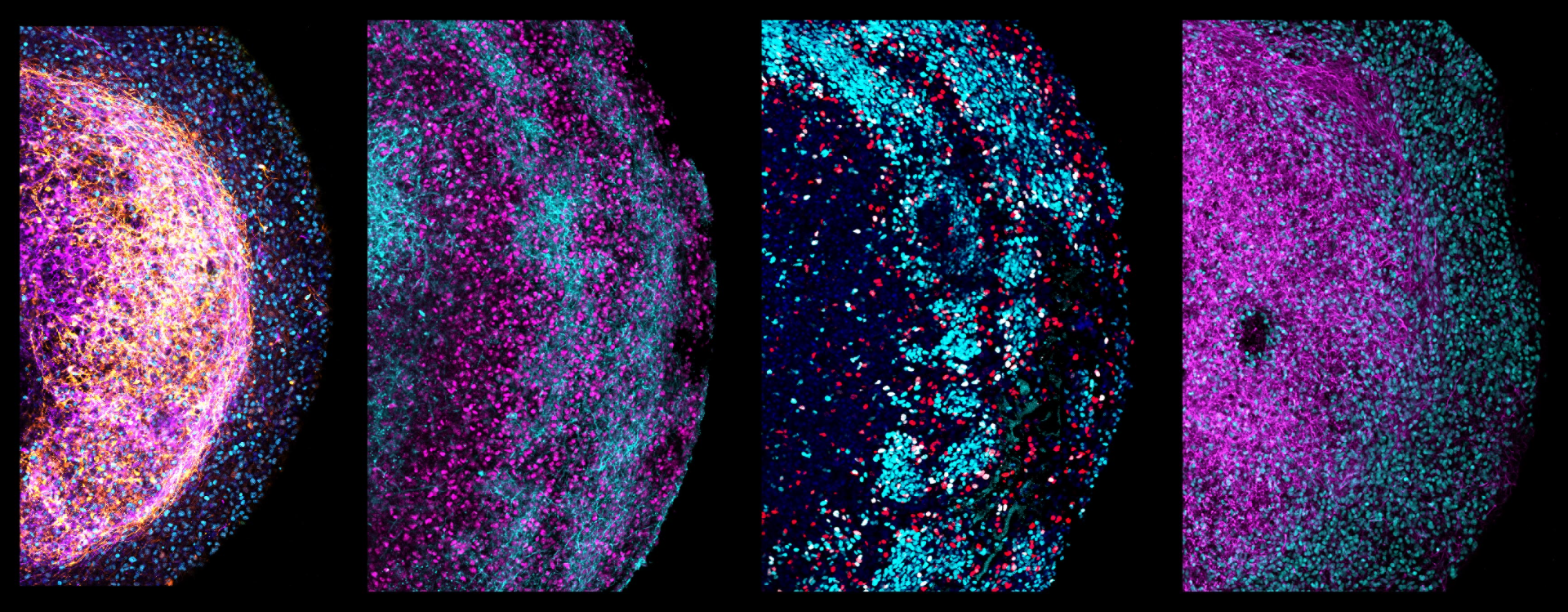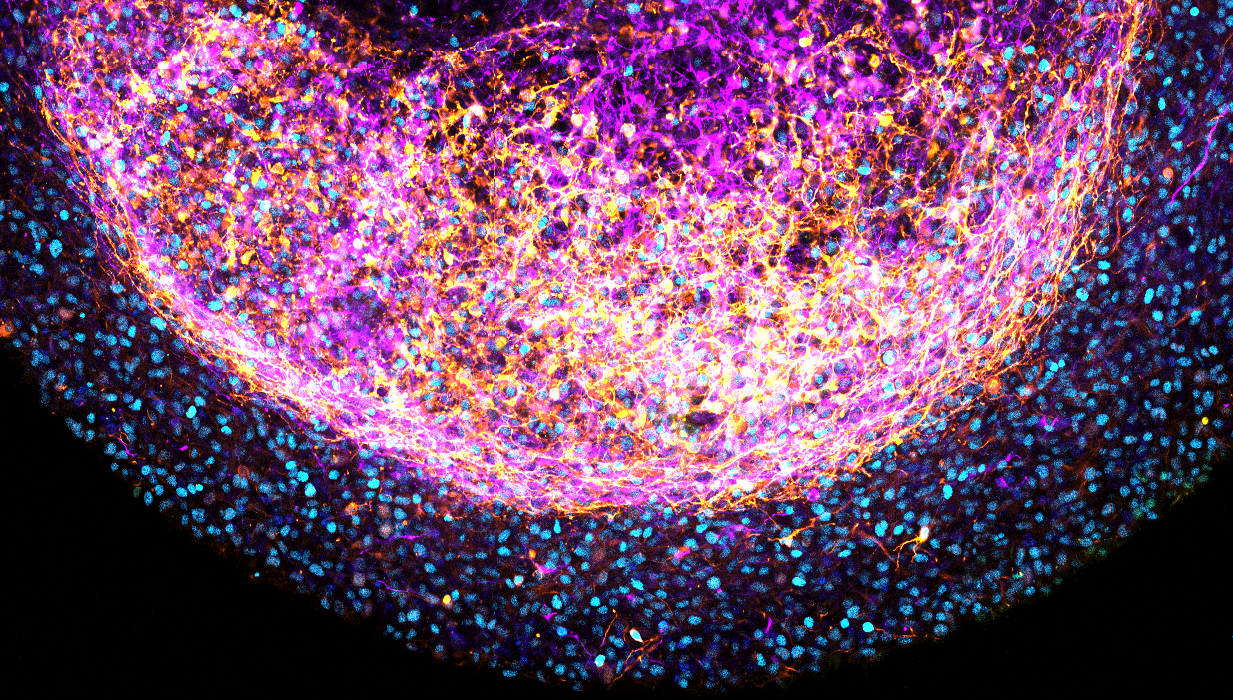
Four zoom-in images of parts of different human fetal brain organoids. Different neural markers are stained, depicting their cellular heterogeneity and architecture. Credits: Artegiani, Hendriks, Clevers.
Scientists use different ways to model the biology of healthy tissue and disease in the lab. These include cell lines, laboratory animals and, since a few years, 3D mini-organs. These so-called organoids have characteristics and a level of complexity that allows scientists to closely model the functions of an organ in the lab. Organoids can be formed directly from cells of a tissue. Scientists can also ‘guide’ stem cells – found in embryos or in some adult tissues – to develop into the organ they aim to study.
Until now, brain organoids were grown in the lab by coaxing embryonic or so-called pluripotent stem cells to grow into structures representing different areas of the brain. Using a specific cocktail of molecules, they would try to mimic the natural development of the brain – with the ‘recipe’ for each cocktail taking a lot of research to develop.
Organoids from tissue
Now, scientists at the Princess Máxima Center and the Hubrecht Institute developed brain organoids directly from human fetal brain tissue. The study was published in the prestigious journal Cell today and was funded by the Dutch Research Council.
The researchers, led by Dr. Delilah Hendriks, Prof. Dr. Hans Clevers and Dr. Benedetta Artegiani, were surprised to find that using small pieces of fetal brain tissue rather than individual cells was vital in growing mini-brains. To grow other mini-organs such as gut, scientists normally break down the original tissue to single cells. Instead working with small pieces of fetal brain tissue, the team found that these pieces could self-organize into organoids.
Valuable features
The brain organoids were roughly the size of a grain of rice. The scientists found they had a number of features that make them particularly valuable to study the human brain. Firstly, the tissue’s 3D make-up was complex. It contained a number of different types of brain cells, including so-called outer radial glia – a cell type found in humans and our evolutionary ancestors. The organoids also produced proteins that make up extracellular matrix – a kind of ‘scaffolding’ around cells. Finally, the organoids kept various characteristics of the specific region of the brain from which they were derived and responded to molecules directing their development.
Potential for cancer drug research
Given the ability of the tissue-derived organoids to quickly expand, the team next investigated their potential in modeling brain cancer. The researchers used gene-editing technique CRISPR-Cas9 to introduce faults in the well-known cancer gene TP53 in a small number of cells in the organoids. After three months, the cells with defective TP53 had completely overtaken the healthy cells in the organoid – meaning they had acquired a growth advantage, a typical feature of cancer cells.
They then used CRISPR-Cas9 to switch off three genes linked to the brain tumor, glioblastoma: TP53, PTEN and NF1. The researchers also used to look at their response to existing cancer drugs. These experiments showed the organoids’ potential for cancer drug research to link certain drugs to specific gene mutations.

A zoom-in image of a part of a human fetal brain organoid. Stem cells are marked by SOX2 (cyan) and neuronal cells (TUJ1) are color coded from pink to yellow based on depth. Credits: Artegiani, Hendriks, Clevers.
Reliability
The tissue-derived organoids continued to grow in a dish for more than six months. Importantly, the scientists could multiply them, allowing them to grow many similar organoids from one tissue sample. The mini-tumors with the glioblastoma gene changes were also capable of multiplying, keeping the same mix of mutations. This feature means scientists can carry out repeat experiments with the tissue-derived organoids, increasing the reliability of their findings.
Healthy and derailed brain development
Dr. Benedetta Artegiani, research group leader at the Princess Máxima Center who co-led the research, says: ‘Brain organoids from fetal tissue are an invaluable new tool to study human brain development. We can now more easily study how the developing brain expands, and look at the role of different cell types and their environment.
‘Our new, tissue-derived brain model allows us to gain a better understanding of how the developing brain regulates the identity of cells. It could also help understand how mistakes in that process can lead to neurodevelopmental diseases such as microcephaly, as well as other diseases that can stem from derailed development, including childhood brain cancer.’
New discoveries
Dr. Delilah Hendriks, affiliated group leader at the Princess Máxima Center, postdoctoral researcher at the Hubrecht Institute and Oncode Investigator, who co-led the research, says: ‘These new fetal tissue-derived organoids can offer novel insights into what shapes the different regions of the brain, and what creates cellular diversity. Our organoids are an important addition to the brain organoid field, that can complement the existing organoids made from pluripotent stem cells. We hope to learn from both models to decode the complexity of the human brain.
‘Being able to keep growing and using the brain organoids from fetal tissue also means that we can learn as much as possible from such precious material. We’re excited to explore the use of these novel tissue organoids for new discoveries about the human brain.’
Mini-organs
Prof. dr. Hans Clevers, pioneer in organoid research and former research group leader at the Hubrecht Institute and the Princess Máxima Center and Oncode Investigator, co-led the research. He says: ‘With our study, we’re making an important contribution to the organoid and brain research fields. Since we developed the first human gut organoids in 2011, it’s been great to see that the technology has really taken off. Organoids have since been developed for almost all tissues in the human body, both healthy and diseased – including an increasing number of childhood tumors. Until now, we were able to derive organoids from most human organs, but not from the brain – it’s really exciting that we’ve now been able to jump that hurdle as well.’
The study was performed in collaboration with Leiden University Medical Center, Utrecht University, Maastricht University, Erasmus University Rotterdam, and National University of Singapore.
Do you have any questions about this research? Please read the Questions and Answers page.

